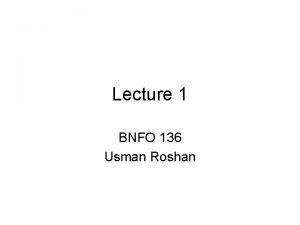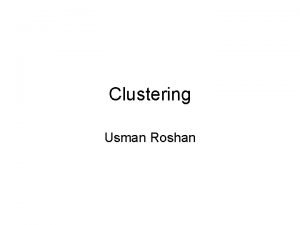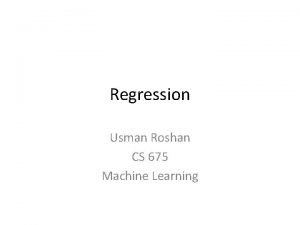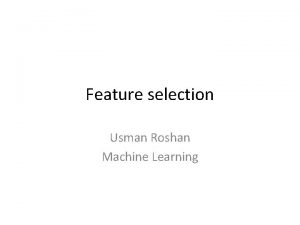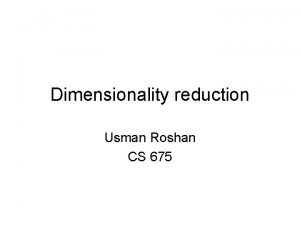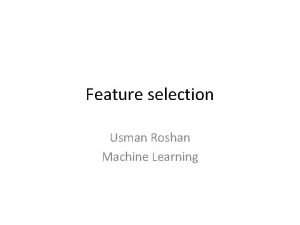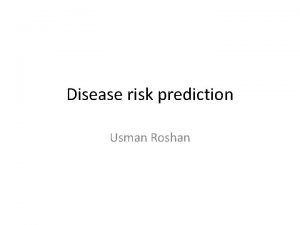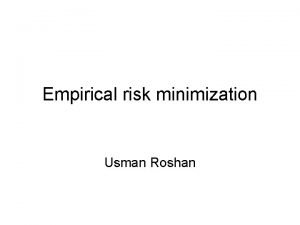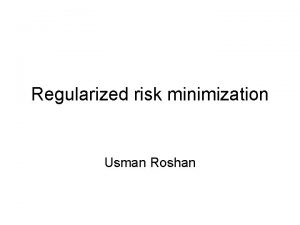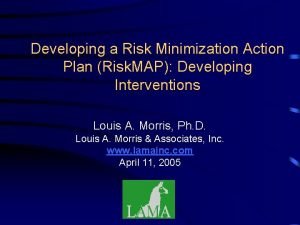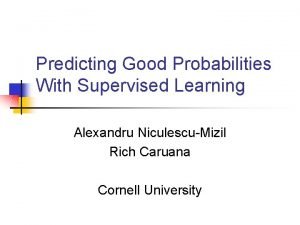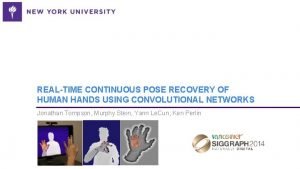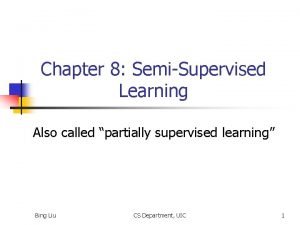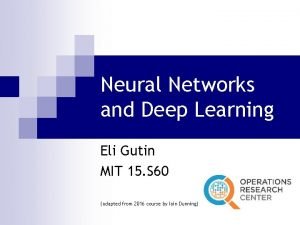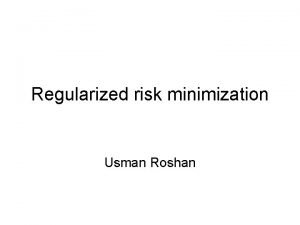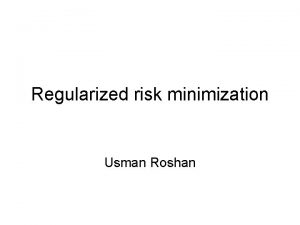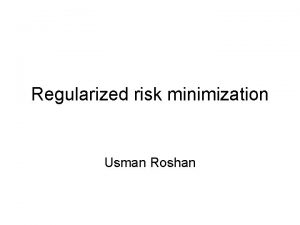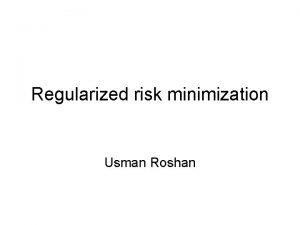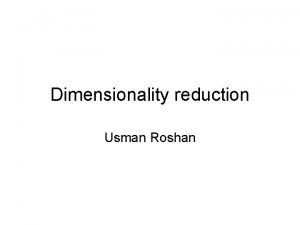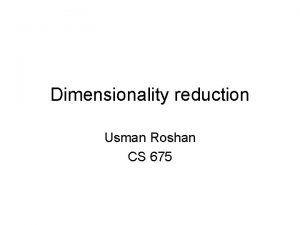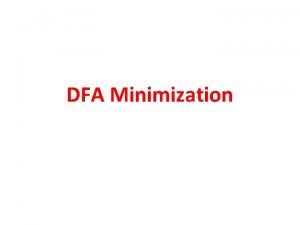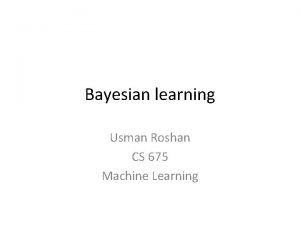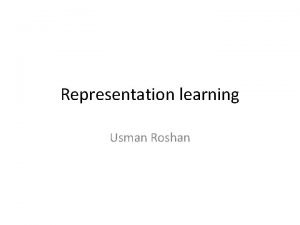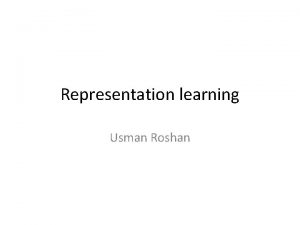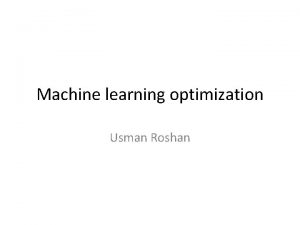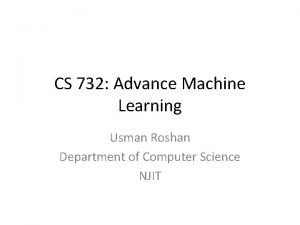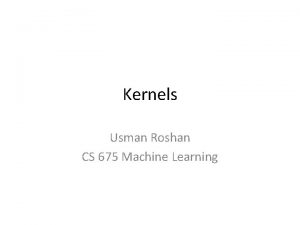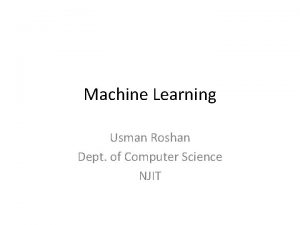Empirical risk minimization Usman Roshan Supervised learning for


![Loss function • Loss function: c(x, y, f(x)) • Maps to [0, inf] • Loss function • Loss function: c(x, y, f(x)) • Maps to [0, inf] •](https://slidetodoc.com/presentation_image_h/26c50169bee605566ca1fd61371b4504/image-3.jpg)



















- Slides: 22

Empirical risk minimization Usman Roshan

Supervised learning for two classes • We are given n training samples (xi, yi) for i=1. . n drawn i. i. d from a probability distribution P(x, y). • Each xi is a d-dimensional vector (xi in Rd) and yi is +1 or -1 • Our problem is to learn a function f(x) for predicting the labels of test samples xi’ in Rd for i=1. . n’ also drawn i. i. d from P(x, y)
![Loss function Loss function cx y fx Maps to 0 inf Loss function • Loss function: c(x, y, f(x)) • Maps to [0, inf] •](https://slidetodoc.com/presentation_image_h/26c50169bee605566ca1fd61371b4504/image-3.jpg)
Loss function • Loss function: c(x, y, f(x)) • Maps to [0, inf] • Examples:

Test error • We quantify the test error as the expected error on the test set (in other words the average test error). In the case of two classes: • We want to find f that minimizes this but we need P(y|x) which we don’t have access to.

Expected risk • Suppose we don’t have test data (x’). Then we average the test error over all possible data points x • This is also known as the expected risk or the expected value of the loss function in Bayesian decision theory • We want to find f that minimizes this but we don’t have all data points. We only have training data. • And we don’t know P(y, x)

Empirical risk • Since we only have training data we can’t calculate the expected risk (we don’t even know P(x, y)). • Solution: we approximate P(x, y) with the empirical distribution pemp(x, y) • The delta function δx(y)=1 if x=y and 0 otherwise.

Empirical risk • We can now define the empirical risk as • Once the loss function is defined and training data is given we can then find f that minimizes this.

Example of minimizing empirical risk (least squares) • Suppose we are given n data points (xi, yi) where each xi in Rd and yi in R. We want to determine a linear function f(x)=ax+b for predicting test points. • Loss function c(xi, yi, f(xi))=(yi-f(xi))2 • What is the empirical risk?

Empirical risk for least squares Now finding f has reduced to finding a and b. Since this function is convex in a and b we know there is a global optimum which is easy to find by setting first derivatives to 0.

Maximum likelihood and empirical risk • Maximizing the likelihood P(D|M) is the same as maximizing log(P(D|M)) which is the same as minimizing -log(P(D|M)) • Set the loss function to • Now minimizing the empirical risk is the same as maximizing the likelihood

Empirical risk • We pose the empirical risk in terms of a loss function and go about to solve it to get our classifier. • Input: n training samples xi each of dimension d along with labels yi • Output: a linear function f(x)=w. Tx+w 0 that minimizes the empirical risk

Empirical risk examples • Linear regression • How about logistic regression?

Logistic regression • In the logistic regression model: • Let y=+1 be case and y=-1 be control. • The sample likelihood of the training data is given by

Logistic regression • We find our parameters w and w 0 by maximizing the likelihood or minimizing the -log(likelihood). • The -log of the likelihood is

Logistic regression empirical risk

Hinge loss empirical risk • Hinge loss: • Risk:

Different empirical risks • Linear regression • Logistic regression • Hinge

Does it make sense to optimize empirical risk? • Does Remp(f) approach R(f) as we increase sample size? • Remember that f is our classifier. We are asking if the empirical error of f approaches the expected error of f with more samples. • Yes according to law of large numbers: mean value of random sample approaches true mean as sample size increases • But how fast does it converge?

Chernoff bounds • Suppose we have Xi i. i. d. trials where each Xi = |f(xi)-yi| • Let m be the true mean of X • Then

Convergence issues • Applying Chernoff bound to empirical and expected risk give us • Remember we fix f first before looking at data. So this is not too helpful. • We want to show a bound with the best function estimation

Bound on empirical risk minimization • In other words bound: • With some work we can show that where N(F, 2 n) measures the size of function space F. It is the maximum size of F on 2 n datapoints. Since we can have at most 22 n binary classifiers on 2 n points the maximum size of F is 22 n.

Structural risk/regularized risk minimization • We can rewrite the previous bound as • Compare to regularized risk minimization
 Bnfo
Bnfo Njit machine learning
Njit machine learning Usman roshan
Usman roshan Cs 675 njit
Cs 675 njit Usman roshan
Usman roshan Usman roshan
Usman roshan Usman roshan
Usman roshan Usman roshan
Usman roshan Empirical risk minimization python
Empirical risk minimization python Supervised learning dan unsupervised learning
Supervised learning dan unsupervised learning Perbedaan supervised dan unsupervised learning
Perbedaan supervised dan unsupervised learning Regularized risk minimization
Regularized risk minimization Risk minimization action plan
Risk minimization action plan Market risk credit risk operational risk
Market risk credit risk operational risk Predicting good probabilities with supervised learning
Predicting good probabilities with supervised learning Supervised learning pipeline
Supervised learning pipeline Partially supervised learning
Partially supervised learning Deep reinforcement learning example
Deep reinforcement learning example Supervised and unsupervised learning
Supervised and unsupervised learning Deep q network
Deep q network Rohana roshan
Rohana roshan Roshan chitrakar
Roshan chitrakar Roshan dalvi
Roshan dalvi
